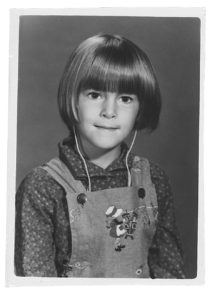Our Hidden Treasures
 Accepting who we are and what we are at times is most complex obstacle in our lives, however, with acceptance comes confidence and strength. American author and illustrator, Cecelia Carolina “Cece” Bell (on the image), is her own inspiration into illustrating a book where the protagonist finds herself lost at a battle with her condition, such book is called “El Deafo”. Readers as the deaf community, those of deaf family members or friends, fans of Bell’s works, and teachers find themselves in a reality of how many view their conditions as their own limitation as well as their flaw. However, Bell supports, in “El Deafo”, that embracing yourself can be your greatest asset in life, Bell develops this through the usage of simile and metaphors.
Accepting who we are and what we are at times is most complex obstacle in our lives, however, with acceptance comes confidence and strength. American author and illustrator, Cecelia Carolina “Cece” Bell (on the image), is her own inspiration into illustrating a book where the protagonist finds herself lost at a battle with her condition, such book is called “El Deafo”. Readers as the deaf community, those of deaf family members or friends, fans of Bell’s works, and teachers find themselves in a reality of how many view their conditions as their own limitation as well as their flaw. However, Bell supports, in “El Deafo”, that embracing yourself can be your greatest asset in life, Bell develops this through the usage of simile and metaphors.
To begin with, Bell utilizes simile very often, which not only adds to the great imagination of child, but it also emphasizes how certain situations feel like or actually are like. For instance, in page 47, Cece states “it feels like I’m always inside a bubble”. In addition, metaphors alike the “bubble of loneliness” are seen all throughout the book. The “bubble of loneliness” (page 46) is quite self -explanatory due to the illustrations, however, this bubble is a sense of isolation Cece enters herself into, although, this bubble bursts at the sight of somebody who gives her attention. Bell’s use of such devices allows readers to widen their perspective on the protagonist and towards the hidden realism where at times we are underestimated, just as we underestimate ourselves too. And as we learn to surpass such pessimistic views of ourselves, we achieve a sense of inner strength.
The Power Within Us
American journalist and theater reporter at The Times and The Boston Globe, Michael Paulson, reached the deaf community along with directors, actors, and Broadway fans through an eye opening review, “Lauren Ridloff’s Quiet Power: ‘My Life Has Changed in Every Way’, where he touches Ridloff’s life as an actor that strengthens the deaf community with her bravery and powerful character as a deaf performer. Through the use of persuasive elements like Ethos, and Pathos, Paulson is able to communicate with the audience.
To begin with, Paulson’s usage of Ridloff’s background causes the audience to understand more of her while connecting to those who are either deaf, raised by parents who are deaf or know somebody who is deaf. This connection is quite emotional, and relatable which connects to Pathos. Afterwards, quotes from people who have met the actor later develop this sense of credibility (Ethos) where it can be seen how Paulson draws evidence to support his opinion and positive perspective towards the actor. These persuasive elements are effective given the author’s specific purpose to strengthen and raising awareness to the deaf community by showcasing a successful actress that shines with her “quiet power”.
Almost Perfect
The life of young Cece gets less complicated as she meets her new, good neighbor, Martha. This new friend shows Cece what her last two “friends” lacked in many ways. A friendship lays on the basics of sincerity, loyalty, and positivity. This new relationship is exactly what Cece needs after falling into toxic, manipulative grasp of Ginny, the girl who rudely reminds everyone how ‘special’ Cece is, and Laura, the controlling one that never let Cece do as she wished. And in the midst of loneliness, Martha comes gently into Cece’s life showing her what a true sleepover should be like, how people should treat each other no matter the differences between them. However, in a turn of events, Martha no longer wants to associate with Cece. No longer does Cece have a friend, now she lies in solace again, stuck in a never ending cycle of bad endings and bad friendships. Maybe later on throughout the book Cece will meet someone that’ll truly be her friend and stick through the good and the bad times.



